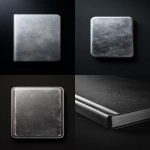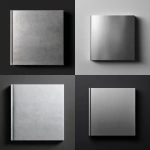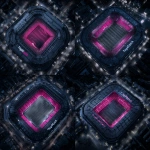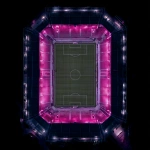Explore the Best AI Image Gallery

Edge Computing: Transforming Creativity and Innovation
As we dive deeper into the digital age, the concept of edge computing is emerging as a powerful force reshaping how businesses and creators operate. It revolves around the idea of processing data closer to the source, rather than relying on a centralized data center. This shift not only enhances data processing speeds but also opens new avenues for creativity, especially in industries such as art, design, and entertainment.
The Creative Industry: A New Frontier
In the realm of the creative industry, the integration of edge computing facilitates real-time data processing, significantly enhancing the art of storytelling and user engagement. For instance, consider interactive installations that use augmented reality (AR). Edge computing allows these installations to react and adapt in real-time based on user interactions, creating unique experiences for each participant. This not only revolutionizes visitor engagement but also enables artists to push the boundaries of traditional art forms.
Moreover, filmmakers can leverage this technology for on-the-spot editing and visual effects. It reduces latency issues, ensuring smoother editing processes and instant feedback during production. This capability empowers creators to focus on storytelling and artistic expression rather than technical hindrances.
Potential Uses of Edge Computing in Creative Applications
The application of edge computing extends beyond just enhancing art installations or film production. Here are several potential uses that highlight its versatility:
- Real-Time Collaboration: Edge computing enables creators around the world to collaborate seamlessly. For example, musicians can record and mix tracks simultaneously, regardless of their physical location, enhancing the creative process.
- Dynamic Content Delivery: In digital marketing, edge computing allows for personalized ad experiences tailored to individual consumers by processing data swiftly and efficiently.
- Enhanced Gaming Experiences: The gaming industry can harness edge computing to improve multiplayer experiences by minimizing lag and latency, creating a more immersive environment for gamers.
- Smart Wearables: Artists can explore wearables that leverage edge computing to create performance art. For example, smart clothing can analyze data from the wearer, juxtaposing it with visual displays in real-time.
Ethical Considerations in Edge Computing
As with any transformative technology, edge computing raises ethical considerations that warrant discussion. Data privacy is at the forefront, especially as edge computing processes vast amounts of personal information. Creatives must consider how their projects handle sensitive data to protect user privacy. This includes adhering to regulations like GDPR and ensuring transparency in data usage.
Additionally, there are concerns about the energy consumption of edge devices. As the demand for real-time data processing grows, ensuring sustainability should be a priority. Creators and developers need to strike a balance between technological advancement and environmental impact, exploring methods like energy-efficient coding and renewable energy sources.
Future Trends: Where Edge Computing is Heading
The future of edge computing in the creative sector is brimming with potential. Some emerging trends to watch include:
- AI-Driven Insights: The integration of artificial intelligence with edge computing will enable creators to derive actionable insights from data collected at the edge. This can enhance artistic decision-making and audience targeting.
- 5G Connectivity: As 5G networks become more widespread, the capability of edge computing will be amplified, allowing for faster processing and more complex, data-driven creative applications.
- Decentralized Creative Spaces: The rise of decentralized platforms will change how art and creativity are produced and shared, allowing for greater collaboration and innovation.
In conclusion, edge computing is not merely a technological trend; it is a transformation that holds immense potential for the creative industry. By enabling real-time processing, it enriches the way creativity is expressed and experienced. As artists and technologists collaborate, the intersection of edge computing and creativity will undoubtedly lead to innovative and ethical practices that redefine the future of art and design. Embracing these changes can inspire a new wave of creativity, merging technology with artistry in unprecedented ways.



](https://images.ai-img.art/thumbnails/150/83ec831b9fb19e0db5a520b051b9556f3f594b87acc957ffee094a06a565e6f0.webp)



](https://images.ai-img.art/thumbnails/150/3ccc82ef0ad0cc1ab1dfb5b8e6bc37924fcad45dadf41cbd1cb21d19fc7f640a.webp)








](https://images.ai-img.art/thumbnails/150/69d81ae5ecde297f3c11da78435c5fc00fbac7b00e2c7ccd89d7bbeb014e0541.webp)










](https://images.ai-img.art/thumbnails/150/908bcb9950a44fd4b37d1a84cf00178988cea9507738d7ad4f92707c692461ef.webp)

](https://images.ai-img.art/thumbnails/150/05b3252b3f681226a3df9027b069db31c005f91b72257a74367c4102f03a2ba0.webp)





](https://images.ai-img.art/thumbnails/150/738b292720ee21b57673dfb75ad851f4c34d16f5006ae3027ba685feaddb6b04.webp)






](https://images.ai-img.art/thumbnails/150/fc468fe14407b96489933a55227127071fd5f6c0505be74ca4dcb2f1e2fa3771.webp)
](https://images.ai-img.art/thumbnails/150/57afc09cc38edf73880f760b7ebe1852c5522c6b4051836717b2e56b6f7f913c.webp)


](https://images.ai-img.art/thumbnails/150/807ac97f95d56e8cc7cf714e13299d80bf6bcb5b4d80b77a7f06f30246184943.webp)